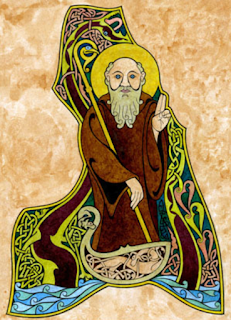Columba of Iona, by Dabile Matsui
Columba of Iona
June 9
In the troubled and violent period in Northern Europe after the collapse of Roman authority in the 500s CE, monasteries served as inns, orphanages, centers of learning, and even as fortresses. The light of civilization flickered dimly and might have gone out altogether if it had not been for these convent-shelters.
Columba (Latin “dove or pigeon,” translated from Irish Colm Cille, 'church pigeon-dove’), was a stern and strong monk from Ireland, founded three such establishments. He founded the monasteries of Derry and Durrow in his native Ireland, and then the island monastery of Iona on the west coast of Scotland within sight of his native Ireland. Iona was the center of operations for the conversion of the Scots and Picts, seen by the southern Britons as wild and savage. (“Picts” were so called in Latin because of their use of body art—probably tattooing—in bluish color from copper pigments and not the indigo-producing from woad shrub, as often thought.). Iona became the most famous religious house in Scotland. There Columba baptized Brude, King of the Picts, and later a King of the Scots came to this Abbot of the "Holy Isle" for baptism.
Saint Bede in his history of the Church in England, tells us that Columba led many to Christianity by his "preaching and example." He was much admired for his physical as well as spiritual prowess. He was a strict ascetic and remained physically vigorous and unflagging in his missionary and pastoral journeys throughout his seventy-six years of life.
A reading from St. Bede’s Ecclesiastical History of England (c. 731 CE).
In the year of our Lord 565, when Justin, the younger, the successor of Justinian, obtained the government of the Roman Empire, there came into Britain from Ireland a famous priest and abbot, marked as a monk by habit and manner of life, whose name was Columba, to preach the word of God to the provinces of the northern Picts, who are separated from the southern parts belonging to that nation by steep and rugged mountains. For the southern Picts, who dwell on this side of those mountains, had, it is said, long before forsaken the errors of idolatry, and received the true faith by the preaching of Bishop Ninias.
Columba came into Britain in the ninth year of the reign of Bridius, who was the son of Meilochon, and the powerful king of the Pictish nation, and he converted that nation to the faith of Christ, by his preaching and example. Wherefore he also received of them the gift of the aforesaid island whereon to found a monastery. It is not a large island, but contains about five families, according to the English computation; his successors hold it to this day; he was also buried therein; having died at the age of seventy-seven, about thirty-two years after he came into Britain to preach.
Before he crossed over into Britain, he had built a famous monastery in Ireland, which, from the great number of oaks, is in the Scottish tongue called Dearmach- The Field of Oaks. From both of these monasteries, many others had their beginning through his disciples, both in Britain and Ireland; but the island monastery where his body lies, has the pre-eminence among them all.
That island has for its ruler an abbot, who is a priest, to whose jurisdiction all the province, and even the bishops, contrary to the usual method, are bound to be subject, according to the example of their first teacher, who was not a bishop, but a priest and monk; of whose life and discourses some records are said to be preserved by his disciples. But whatsoever he was himself, this we know for certain concerning him, that he left successors renowned for their continence, their love of God, and observances of monastic rules.
It is true they employed doubtful cycles in fixing the time of the great festival, as having none to bring them the synodal decrees for the observance of Easter, by reason of their being so far away from the rest of the world; but they earnestly practiced such works of piety and chastity as they could learn from the Prophets, the Gospels, and the Apostolic writings. This manner of keeping Easter continued among them no little time, to wit, for the space of 150 years, till the year of our Lord 715.
But then the most reverend and holy father and priest, Egbert, of the English nation, who had long lived in banishment in Ireland for the sake of Christ, and was most learned in the Scriptures, and renowned for long perfection of life, came among them, and corrected their error, and led them to observe the true and canonical day of Easter.
Bede, The Venerable Bede's Ecclesiastical History of England, trans. A.M. Sellar (London: George Bell & Sons, 1907).













No comments:
Post a Comment